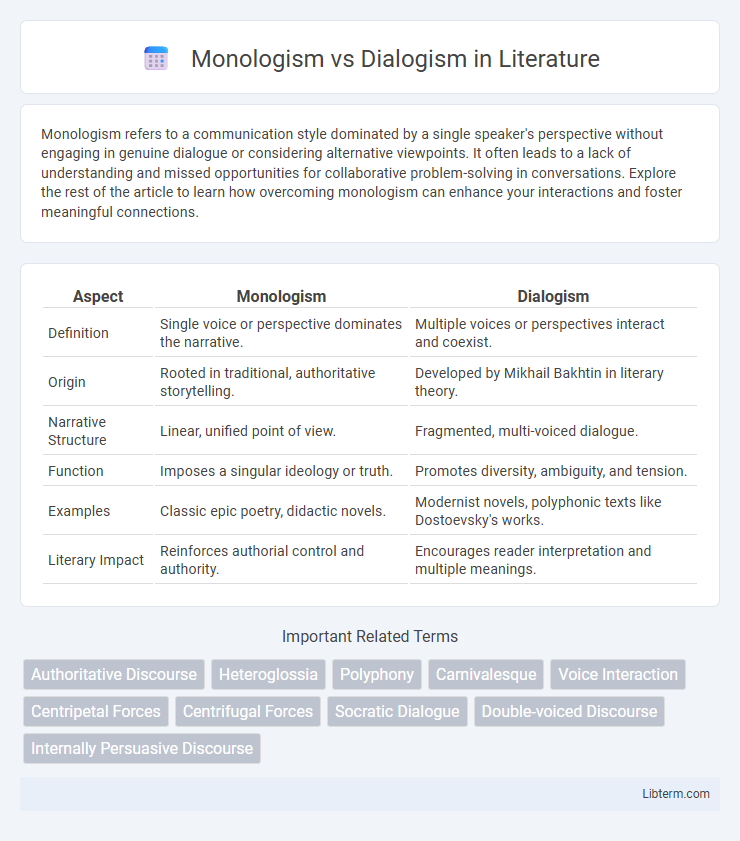Monologism refers to a communication style dominated by a single speaker's perspective without engaging in genuine dialogue or considering alternative viewpoints. It often leads to a lack of understanding and missed opportunities for collaborative problem-solving in conversations. Explore the rest of the article to learn how overcoming monologism can enhance your interactions and foster meaningful connections.
Table of Comparison
| Aspect | Monologism | Dialogism |
|---|---|---|
| Definition | Single voice or perspective dominates the narrative. | Multiple voices or perspectives interact and coexist. |
| Origin | Rooted in traditional, authoritative storytelling. | Developed by Mikhail Bakhtin in literary theory. |
| Narrative Structure | Linear, unified point of view. | Fragmented, multi-voiced dialogue. |
| Function | Imposes a singular ideology or truth. | Promotes diversity, ambiguity, and tension. |
| Examples | Classic epic poetry, didactic novels. | Modernist novels, polyphonic texts like Dostoevsky's works. |
| Literary Impact | Reinforces authorial control and authority. | Encourages reader interpretation and multiple meanings. |
Understanding Monologism and Dialogism
Monologism emphasizes a single, authoritative perspective that excludes alternative voices, often resulting in a fixed or dogmatic understanding of meaning. Dialogism, based on Mikhail Bakhtin's theory, promotes the interaction of multiple voices and perspectives, fostering dynamic and evolving meanings through conversation and exchange. Understanding these concepts highlights the contrast between rigid, univocal communication and fluid, multivocal discourse essential for deeper comprehension and cultural dialogue.
Historical Origins of Monologism and Dialogism
Monologism originated from classical rhetoric and early philosophical traditions emphasizing singular authoritative discourse, as seen in Plato's dialogues and Aristotle's treatises where a single voice dominates the narrative. Dialogism emerged primarily through Mikhail Bakhtin's literary theory in the early 20th century, highlighting the multiplicity of voices and the interaction between diverse perspectives in language and literature. The historical shift from monologism to dialogism reflects a broader cultural movement toward recognizing polyphony and heteroglossia in communication and textual interpretation.
Key Theorists: Bakhtin and Beyond
Bakhtin's theory of dialogism emphasizes the multiplicity of voices and the interactive nature of meaning-making in language, contrasting sharply with monologism, which centers on a singular, authoritative voice. Key theorists expanding on Bakhtin include Mikhail Bakhtin himself, who introduced concepts like heteroglossia and polyphony, and later scholars such as Michael Holquist and Paul Ricoeur, who further explored dialogic processes in literature and philosophy. This theoretical framework challenges traditional monologic perspectives by highlighting the dynamic interplay of diverse perspectives within texts and social discourse.
Defining Features of Monologism
Monologism centers on a single, authoritative voice that asserts truth without inviting alternative perspectives, thereby limiting dialogue and interpretation. Its defining features include closed meaning structures, hierarchical communication, and a lack of genuine interaction between differing viewpoints. This approach contrasts sharply with dialogism, which embraces multiplicity, openness, and co-creation of understanding through ongoing conversational exchange.
Defining Features of Dialogism
Dialogism is characterized by the presence of multiple voices and perspectives that interact dynamically within a text, defying a single, authoritative viewpoint. Its defining features include polyphony, where diverse viewpoints coexist and respond to each other, and heteroglossia, which incorporates various social languages and discourses. Dialogism fosters an open-ended, evolving narrative structure that resists closure and embraces the complexity of meaning generation through relational exchange.
Monologism in Literature and Communication
Monologism in literature and communication emphasizes a single, authoritative voice that dominates the narrative, often suppressing alternative perspectives and limiting interpretive openness. This approach fosters a linear, unidirectional flow of information, reinforcing power structures by presenting a singular truth or ideology. In contrast to dialogism, monologism constrains the dynamic interplay of multiple voices, reducing the complexity and plurality inherent in human discourse.
Dialogism in Literature and Communication
Dialogism in literature and communication emphasizes the coexistence of multiple voices and perspectives within a text or conversation, fostering dynamic interaction and meaning-making. This concept, rooted in Mikhail Bakhtin's theory, highlights how characters or participants engage in an ongoing, responsive exchange that challenges fixed interpretations. Dialogic communication encourages openness, adaptability, and mutual understanding, contrasting sharply with the one-sided nature of monologism.
Comparing Monologism and Dialogism: Core Differences
Monologism centers on a single, authoritative voice that controls meaning, emphasizing a fixed, univocal perspective. Dialogism promotes multiple voices and perspectives, allowing meaning to emerge through interaction and negotiation between diverse viewpoints. The core difference lies in monologism's dominance of uniformity versus dialogism's embrace of heterogeneity and relational understanding.
Implications in Modern Discourse
Monologism in modern discourse emphasizes a single authoritative perspective, limiting the diversity of voices and reinforcing dominant narratives in media and politics. Dialogism promotes multiplicity, encouraging interaction between differing viewpoints, which enhances critical thinking and democratic engagement in digital communication platforms. The tension between these approaches shapes public debate by either constraining or expanding interpretative possibilities in contemporary social and cultural contexts.
The Future of Dialogic and Monologic Approaches
The future of dialogic and monologic approaches hinges on integrating interactive, participatory communication models with traditional authoritative frameworks to enhance understanding and innovation. Dialogism promotes dynamic exchange and co-construction of meaning, essential in digital communication, social media, and collaborative learning environments. Monologism, while often perceived as one-directional, still plays a vital role in delivering structured knowledge and maintaining coherence in formal education, legal discourse, and scientific communication.
Monologism Infographic

 libterm.com
libterm.com